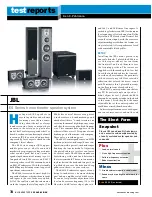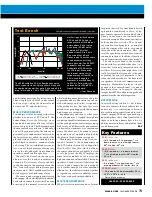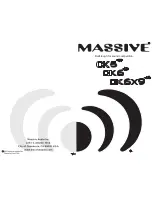
and listening positions. From experience,
I knew to place the ES250P in my room’s
sub sweet spot, along the front wall and
between the TV and the left tower.
MUSIC PERFORMANCE
I started my critical listening with stereo
playback, courtesy of KT Tunstall. Her
debut album,
Eye to the Telescope
, was a
bona-fide hit and proved that not all new
stars need to be Idols. The JBLs reproduced
the muscular bass guitar on “Suddenly I
See” with good musicality; the subwoofer
provided solid fundamental notes while
the towers’ woofers added the attack of the
plucked strings. Likewise, the kick drum,
pulled back in this mix, sounded steady
and strong. The sat/sub blend was seam-
less — one of the advantages of using tow-
ers for the left and right front channels,
instead of small satellite speakers.
Tunstall’s lead vocal on the song was
clean, as was the touch of reverberation
around it. Details were clearly audible,
such as nuances in the vocal echoes on the
line “I can see her eyes looking from a page
in a magazine.” That I could hear all of this
detail suggests good midrange clarity.
The snare sound was appropriately crisp
and snappy, albeit a bit brighter than what
I’ve heard on some other systems. The com-
bination of the normal tweeter and the
ultra-high-frequency driver served up lots
of presence and air. The entire top end siz-
zled with energy, and, in fact, it required a
little getting used to. But once I got accli-
mated, I was quite happy with that extreme
high-frequency extension.
Expanding my audition to other faves
both old and new, I worked through my
evaluation checklist. Imaging was accurate,
with a good phantom-center image on pop
lead vocals, and likewise the panorama of
orchestral instruments was continuous
across the stereo arc. The soundstage was
open and natural, undoubtedly aided by
the plentiful high-frequency response.
Turning my attention to music in sur-
round, I listened to the 6-channel mix on
the DVD-Audio edition of Led Zeppelin’s
How the West Was Won
. On this album,
the center channel is used lightly for lead
vocals, but since the ES25C employs the
same tweeter module as the towers, the
high end sounded well matched. The center
speaker’s 5-inch woofer falls between the
towers’ 4- and 6-inchers, but its tonal qual-
ity is similar enough. On other surround
albums, too, these drivers worked together
to reproduce a realistic soundstage across
the front, with good image definition.
MOvIE PERFORMANCE
JBL got its start in movie sound, so I wasn’t
surprised that its ES system handled with
aplomb the soundtrack to
Hero
, a Chi-
nese fantasy spectacle directed by Yimou
Zhang. In one scene, the titular charac-
ter swirls around a blue room, cutting ties
holding bundles of sticks. The swoosh-
ing sounds of our flying hero, co-mingled
with the ringing of his sword, are panned
throughout the surround mix. Here, the
satellite speakers provided great spatial
continuity instead of the blobs of localized
sound I sometimes hear on other models.
The subwoofer added to the swirling
sound with low-pitched whooshes — an
effect that was nicely integrated with the
satellites. (A lesser system might have stat-
ically localized the low sounds to the sub,
degrading the sense of movement.) And
when the sticks crashed to the floor in all
six speakers, the sense of immersion was
complete. Meanwhile, dialogue — hard-
panned to the center channel — sounded
absolutely clean. As I expected, the cen-
ter speaker’s MTM configuration produced
symmetrical horizontal dispersion.
BOTTOM LINE
In a world of tiny satellites — not to men-
tion cute cabinets that are subwoofers in
name only — it’s comforting to listen to
big, traditional speakers from a big, tradi-
tional company. JBL has a speaker-design
knowledge base that’s almost unrivaled. If
there’s one thing it knows how to do, it’s
putting drivers in boxes and making them
sound damn good.
S&V
ES80
($549 each)
::
(2) 6-in woofers; 4-in midrange;
3
⁄
4
-in
dome tweeter;
3
⁄
4
-in ultra-high tweeter;
42
3
⁄
4
in high; 46
1
⁄
4
lb
ES25C
($349)
::
(2) 5-in woofers;
3
⁄
4
-in dome tweeter;
3
⁄
4
-in ultra-high tweeter; 18
3
⁄
4
in wide;
16
3
⁄
4
lb
ES10
($349/pair)
::
4-in woofer;
3
⁄
4
-in dome tweeter;
3
⁄
4
-in
ultra-high tweeter; 12 in wide; 8
3
⁄
4
lb
ES250P
($599)
::
12-in woofer; 400-watt amplifier; 19
3
⁄
4
x 15
3
⁄
4
x 16
7
⁄
8
in; 43 lb
::
Finish: black or cherry
JBL.COM :: 516-255-4525
Key Features
Test Bench
Full lab results at soundandvisionmag.com/jbles
Surround
■■
85 Hz to 17.8 kHz ±6.2 dB
Subwoofer
■■
34 Hz to 103 Hz ±1.9 dB
L/R
■■
46 Hz to 15 kHz ±7.6 dB
Center
■■
83 Hz to 14.8 kHz ±7.8 dB
The ES80 exhibits a 300-Hz floor-bounce notch
that’s typical for tower-style speakers, along with
narrow band irregularities up to 2 kHz and a 5-dB
drop in level above 7 kHz. The ES25C center shows
similar irregularities between
800 Hz and 6 kHz, and its
response tails off at 6 dB per
octave above 6 kHz. It also
has a deep (20 dB) notch
centered at 3 kHz that
extends from 1.6 to 6 kHz.
Be assured that off-axis
listeners won’t hear the same
sound as someone sitting
front and center. The ES250P
subwoofer only has upper
bandwidth of 103 Hz using
the LFE input. When using
the internal crossover, its
response ranges from 52 to
81 Hz, even though the
crossover is marked from 50
to 150 Hz. To its credit, the
sub can deliver 105 dB SPL
from 32 Hz upward.
—
Tom Nousaine
de
ci
be
ls
(d
B)
15
10
5
0
–5
–10
–15
20 100 1K 10K 20K
hertz (Hz)
soundandvisionmag.com
SOUND & VISION
july/august 2008
71




















